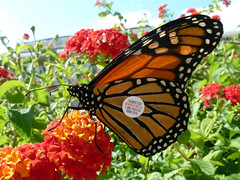Monarch Butterflies: The Life & Science
Monarch Butterflies: Migratory Patterns & Citizen Scientists Opportunities

What to organize a Monarch Butterfly tagging effort? Monarch Watch has instructions and kits with tags for tracking.
Monarch butterflies make perhaps the most epic of all migratory journeys. Though their long trek can sometimes take up to four generations to complete, it spans an almost unbelievably large portion of North America. The butterflies begin high in the mountains of southwestern Mexico, and, come springtime, gradually work their way as far north as Saskatchewan, Canada and as far east as Maine and the southernmost parts of New Brunswick. The distinctive black-and-orange butterflies lay their eggs along the way, and depend on the availability of milkweed-filled habitat throughout their journey. While no one butterfly makes the round trip from Mexico to Maine and back again, the pattern of monarch movement across the continent is incredibly sophisticated and, at times, beautiful.
Because the monarch needs such specific habitat – young monarch caterpillars eat only milkweed – the opportunity to stop and lay eggs has become much more limited than it once was. Due to human development of land and genetically engineered farming techniques, meadows with milkweed can be rare, and the butterflies must try much harder in order to complete the full cycle of their journey. In order to track the changes in population and the preferred landing grounds of monarchs, a number of Citizen Scientist initiatives have been developed. All around the United States (with the exception of states west of the Rockies), butterflies are being tracked and studied – and your family can help as a citizen scientist…
Before becoming a family of Citizen Scientists, learn more about the monarch’s migration by watching this terrific educational video published by Atlantic Public Media. The video gives a tour of the migration pattern using Google Earth, and pairs the tour with lots of information about butterfly projects and butterfly facts:
Then, learn about ways that you can help! Journey North, a website offering place-based citizen scientist projects that can apply to geographic locations nation- and world-wide, holds an annual program called Monarch Butterfly, which tracks the migration and hatching of the butterflies. Participating families are asked to start the program in early spring, when monarchs are just beginning their journey. Throughout the process, families learn all about butterflies and get to collect and submit their own data on local monarch populations. Though the chance to participate in this year’s program has long since passed, the program’s website includes all of the data collected this year – find out how many of the fluttery creatures have been spotted in your area, then go searching yourself!
Along with the butterfly tracking program, Journey North also offers educational resources about migratory creatures of all kinds. Videos, slideshows, stories, challenges, and more are available for adults to peruse and select for use with kids, and there’s even a kid-friendly version that older students can access themselves.
Finally, supplement your learning and monarch-searching with community-based resources where families can meet native & exotic species of butterflies, including Hitchcock Center in Amherst, MA and Magic Wings Butterfly Conservatory & Gardens in South Deerfield, MA.
[Photo credit: (ccl) Katja Schulz]
 Hilltown Families
Hilltown Families 




























